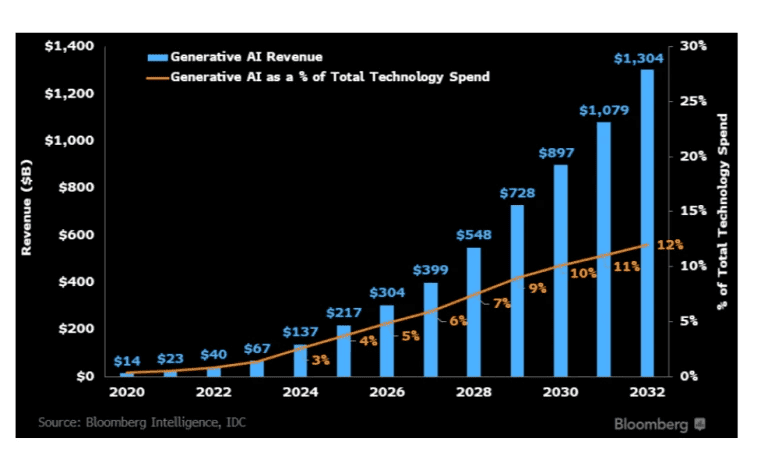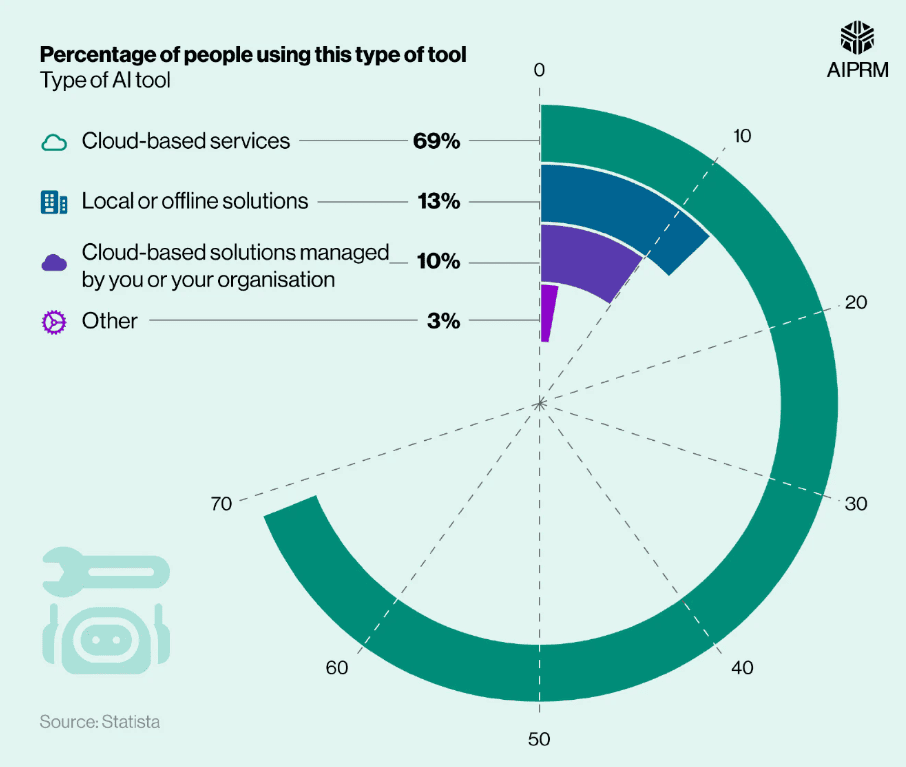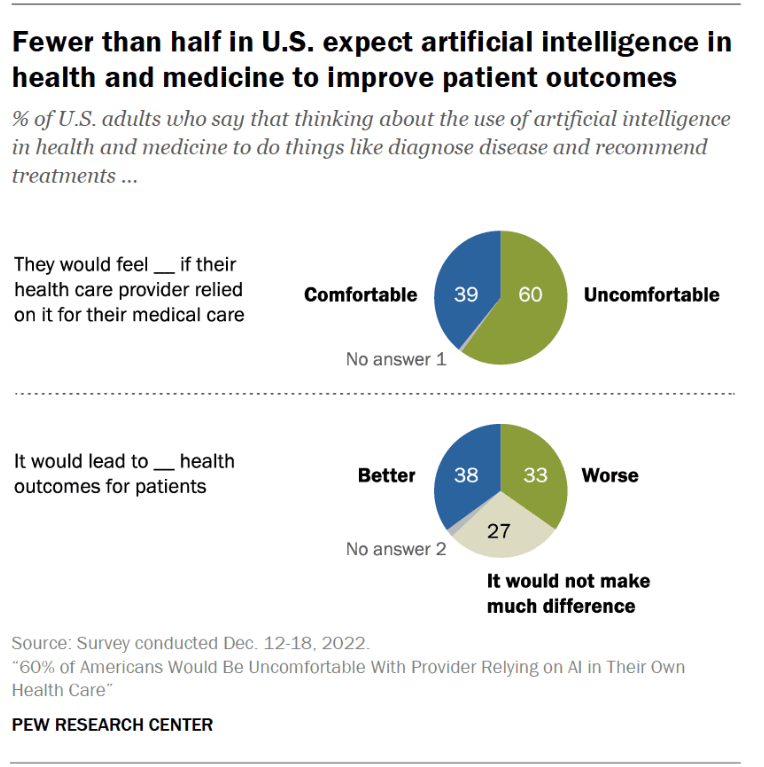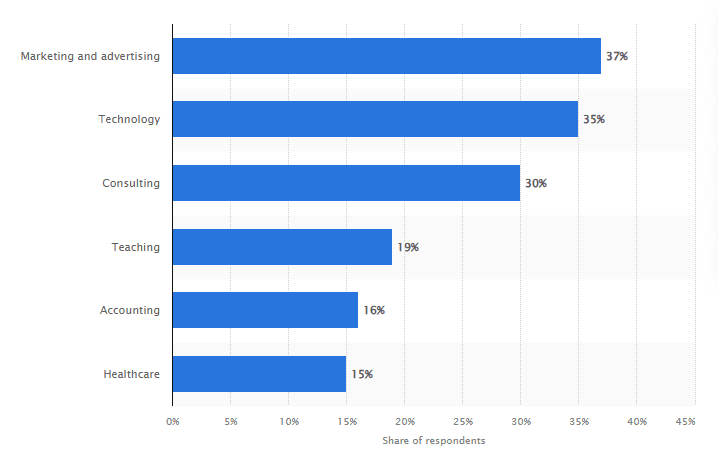If 2023 was the year the world discovered generative AI (gen AI), 2024 is the year organizations truly began unlocking its potential and driving real business value.
Major players like Google, Amazon, and Meta have entered the AI arena, making advanced generative AI technology more accessible to consumers and developers alike.
These companies are already seeing tangible results, reporting both cost reductions and revenue growth in the areas where they’ve implemented gen AI.
But how exactly is generative AI making this happen?
These generative AI stats will give you a clear picture of how it’s impacting everyone—from individuals in the workforce to entire industries.

What is Generative AI?
Generative AI is transforming workflows for creatives, engineers, researchers, scientists, and countless others. Its applications and potential extend across industries and individuals alike.
These models can take inputs like text, images, audio, video, or code and create entirely new content in any of these formats.
For instance, generative AI can turn text into a picture, transform an image into a song, or convert video into text.
Top Generative AI Stats
Generative AI has a lot of benefits that are making it super popular.
It can save time by automating tasks like content creation, coding, or even customer support. It also boosts creativity, helping people come up with new ideas or designs. Plus, businesses use it to improve efficiency, cut costs, and deliver better products or services faster.
Here are some top Generative AI stats that show just how impactful it is for businesses and individuals:
1. The global generative AI market is booming, currently worth $44.89 billion. It is estimated to be $66.62 billion in 2024. Back in 2022, it was just $29 billion. Today, it’s already nearing $50 billion—showing a massive 54.7% growth in just two years.

Generative AI market size
2. GPT-4, OpenAI’s flagship model, is the clear leader in the MMLU benchmark for AI models, scoring a jaw-dropping 86%.
3. By 2025, AI is expected to cut 85 million jobs—but it’s also set to create 97 million new ones, leaving us with a net gain of 12 million jobs.
4. A recent McKinsey survey showed that 65% of organizations now use generative AI regularly, nearly doubling from ten months ago.
5. ChatGPT, launched by OpenAI in November 2022, hit 1 million users in just 5 days. To put that in perspective, Instagram took around 2.5 months to get there, and Netflix took about 3.5 years.

Time it took for selected online services to reach one million users
6. North America dominates the generative AI market, accounting for 41% of its global value—the largest share of any region.
7. Over two-thirds (68%) of generative AI users have tried it for asking questions, making it the most common use case.
8. Almost every American surveyed knows about generative AI, and more than half (53%) have actually used it.
9. People mainly use generative AI for personal tasks (81%), followed by work (30%) and school (17%).
10. Some popular ways people use generative AI include:
- Research and brainstorming (64%)
- Writing first drafts (44%)
- Making visuals or presentations (36%)
- Searching for alternatives to Google (32%)
- Summarizing text (31%)
- Creating images or art (29%)
- Writing code (21%)

Common ways to use generative AI
11. A survey by Botco found that 73% of marketing pros use generative AI to create content, with 55% choosing ChatGPT as their go-to tool.
12. Adobe Analytics reported huge spikes in website traffic thanks to generative AI tools. Retail site traffic jumped by 304%, while travel site traffic shot up by 553% year-over-year.
Generative AI Market Size Stats
As more businesses adopt generative AI tools like ChatGPT and Google Bard, the impact on industries worldwide keeps expanding.
Understanding the Generative AI market stats will help you see where the biggest opportunities and challenges lie in this fast-moving space.
13. The AI market is growing fast. It’s expected to hit $305.9 billion in 2024, up from $241.8 billion in 2023. That’s a jump of 26.51% in just one year. By 2030, it could grow to an impressive $738.7 billion.

AI market size in the United States
14. The global generative AI market is set to reach $66.62 billion by the end of this year. A big chunk of this growth comes from the United States, which is expected to cross $23 billion by year’s end.
15. In the U.S. alone, the generative AI market could grow by 307.13% between 2023 and 2030, reaching $65.71 billion.
16. With popular tools like Google’s Bard and OpenAI’s ChatGPT, the generative AI market is set to explode. According to Bloomberg Intelligence, it’s expected to grow from $40 billion in 2022 to a mind-blowing $1.3 trillion over the next 10 years.

Generative AI can become a $1.3 trillion market by 2032
17. Bloomberg also predicts that demand for generative AI will grow at a super-fast rate of 42% annually. This could bring in $280 billion in new software revenue by 2032.
18. A McKinsey report says generative AI could create an economic impact of $6.1 to $7.9 trillion every year. For some perspective, the World Bank estimated the total global GDP in 1977 was $7.33 trillion.
Generative AI Usage Stats
As AI continues to grow, its uses will expand from improving customer service to enhancing creativity and even transforming industries like healthcare and education.
As more people and businesses see its value, trust in AI will grow, leading to more users and new applications.
Here are some top generative AI market stats that show how this technology is growing and changing the world:
19. Younger generations are using generative AI more than older ones. A Salesforce study with 4,000 participants found that 70% of generative AI users were from Gen Z (born in 1990s and early 2000s).
20. Men also tend to use generative AI tools more than women. In 2023, ChatGPT had 1.5 billion monthly visits, with 69.5% of those visitors being men and 30.5% being women.
21. When it comes to tasks, more than two-thirds (68%) of users turned to generative AI to ask a question, making it the most popular use. Brainstorming came in second, with 54%, and was the only other task used by more than half of users.

Most common ways generative US AI users use the software
22. About 37% of respondents used generative AI to help with photos, while 31% used it for creating music or videos—both tasks were done by more than 30% of users.
23. A recent survey showed that 68% of people unfamiliar with generative AI are from Gen X and the Baby Boomer generation. Of these, 40% don’t know much about it, and 32% don’t find it useful.

Gen AI users by age
24. Nearly half of the most common uses for generative AI involve troubleshooting, technical support, professional and personal help, and learning.
25. There’s a big difference between how men and women feel about kids using AI chatbots. About 31% of men would be comfortable letting their kids use tools like ChatGPT for anything, while only 4% of women would feel the same.
26. When it comes to access, 69% of generative AI users get to it through cloud-based services, five times more than the 13% who use local or offline solutions. Only 10% use their own or company-managed cloud tools.

Most commonly used types of generative AI
Generative AI’s Impact on Business
Generative AI is completely changing the way businesses operate by boosting efficiency, creativity, and decision-making.
From automating tasks like content creation and customer service to helping companies innovate with new products and ideas, AI is making business operations faster and much smarter.
Here are some top generative AI stats that show how businesses are benefiting and using this technology.
27. A Google survey of 50 tech businesses found that 64% of them want to adopt generative AI to improve their operations.

Generative AI adoption rate
28. Deloitte asked 2,620 businesses worldwide about their thoughts on generative AI, and 94% of executives believe it will boost their businesses in the next 5 years. 44% use it for cloud pricing optimization, while 41% apply it for voice assistants, chatbots, and conversational AI.
29. A November 2023 Gartner poll of 821 businesses found that companies could save up to 15.7% in costs over the next 12 to 18 months by investing in generative AI.
30. HubSpot found that chatbots save businesses about 2 hours and 20 minutes on average. Companies using generative AI to write responses to customer service requests save about 2 hours and 11 minutes a day.

Benefits of using Chatbots
31. With the rise of generative AI, jobs in areas like service operations (54%), supply chain management (45%), and HR (41%) are expected to decline.
32. Google’s 2023 report on generative AI showed that nearly two-thirds of business leaders feel a strong need to adopt the technology. However, 62% believe their organizations lack the necessary skills to implement an AI strategy.
33. A February 2024 report by the Financial Times revealed that over 90% (92%) of Fortune 500 companies now use OpenAI technology, the creators of ChatGPT.

AI adoption in Fortune 500 companies
34. The same report found that more than two million software developers are working with OpenAI’s API, with most of them employed by Fortune 500 companies.
35. 55% of organizations said they have little to no expertise in generative AI, while only 9% have very high expertise. 35% of businesses don’t have any expertise in using generative AI at all.
Generative AI’s Impact on Workforce
Generative AI is transforming the workforce by boosting productivity and acting as a helpful teammate, rather than replacing human workers.
As the technology evolves quickly, it shows the need for ongoing learning and skill-building for workers in fields like tech, creative industries, manufacturing, and more, as they begin to use AI in their jobs.
Here are some key generative AI stats that explain how it’s shaping the workforce:
36. Recent studies suggest that AI could automate 60% to 70% of work, freeing time for more creative and strategic thinking.
37. Due to generative AI, nearly 40% of businesses believe they’ll need to reskill over 20% of their employees. This is almost double the number of companies who expect to reskill only 5% or less of their workforce.

Percentage of companies that feel they’ll need to reskill their workforce
38. Fields like product development, data and AI, and sales are expected to see the biggest increase in workers coming from outside those current job areas.
39. According to surveys, data-sharing, intelligence/analytics, and data management are among the most important areas for using generative AI.
40. A large % of workers—76%—say they need AI skills to stay in the job market. Many (69%) believe AI can help them get promoted faster, and 79% say it will open up more job opportunities.
41. According to McKinsey’s 2023 report, 44% of businesses expect generative AI to decrease their workforce in the next three years. 25% think their workforce will shrink by 3-10%, while 10% predict 11-20% cuts. 8% believe their workforce could shrink by over 20% by 2026.

How organizations feel generative AI will affect their workforce over the next three years
42. LinkedIn’s research shows that just 3% of the skills software engineers use are related to people or specialized skills. In contrast, people skills and specialized skills make up 88% of the skills needed by drivers, 89% by oil field operators, and 90% by nurses—making these jobs more resistant to AI.
43. The World Economic Forum predicts a 40% increase in AI and ML specialists by 2027 and a 30-35% rise in demand for data analysts and big data specialists. This will add almost 2.6 million new jobs.

Fastest growing vs. fastest declining jobs due to AI
44. While AI could replace 85 million jobs, it’s expected to create about 97 million new jobs by 2025, resulting in a gain of 12 million jobs.
45. Nearly 75% of surveyed companies are expected to adopt AI, leading to high turnover. According to the Future of Jobs Report, about 50% of organizations believe AI will lead to job growth, while 25% think it will result in job losses.

Tasks completed by humans vs machines
46. Between 2023 and 2027, the demand for specialists in AI, machine learning, sustainability, business intelligence, and information security is set to rise. On the flip side, jobs like bank tellers and clerical roles could be wiped out by 2027.
47. Nearly 10% of U.S. jobs could be at high risk of being replaced by generative AI. However, despite some job losses, many roles—like those of surgeons and housekeepers—are expected to grow at a slower pace.
Generative AI in Industries
Generative AI is changing the way businesses operate across the globe, but industries like healthcare, finance, and software development are seeing some of the biggest impacts.
From speeding up the process of writing code and solving complex problems to lowering research costs in healthcare and improving customer experiences, the potential for growth and innovation is huge.
Here are the top generative AI stats that show how industries are adopting this technology:
48. Software developers using generative AI tools have seen a 25% to 30% improvement in their ability to meet deadlines for complex coding tasks.
49. A study of GitHub users found that developers using a generative AI program completed their tasks 55% faster than those who didn’t use it.
50. Generative AI can help software developers cut the time it takes to write new code by up to 50%.
51. Big financial institutions are using generative AI to understand internal and legal regulations, helping them stay compliant and automate compliance checks.
52. Banks and other financial institutions could invest more than $100 billion in generative AI by 2032.

Which industries benefit the most from AI
53. In banking, generative AI could add between $200 billion and $340 billion in value due to its effectiveness.
54. One study shows that generative AI could assist with up to 34% of the tasks done by bank employees.
55. Generative AI has a nearly 40% success rate in diagnosing difficult medical cases correctly.
56. By 2025, generative AI could help discover up to 30% of new pharmaceutical drugs.
57. Over half (53%) of hospitals and healthcare systems are already incorporating generative AI into their operations.

Majority of Americans would be uncomfortable with provider relying on AI in their own healthcare
58. The customer service industry is leading the way in AI adoption. According to Servion Global Solutions, by 2025, AI might handle about 95% of business interactions.
59. Deloitte predicts that by 2025, about 90% of businesses in the customer service industry will use AI, with more than 74% already testing or using customer chatbots.
Generative AI Adoption: Rates, Trends, and Barriers
Generative AI is quickly being adopted by both businesses and individuals to improve efficiency, creativity, and innovation.
While companies are using it for tasks like customer service and marketing, individuals are tapping into it for personal projects and learning.
However, challenges like lack of expertise and privacy concerns are threatening its use.
Here are some top Generative AI stats that show how people and companies are adopting this technology, what barriers they face, and the trends that are shaping its growth:
60. Botco’s data shows that 69% of marketers are using generative AI for creating images, while 58% are using it for writing text.
61. The survey also found that about 66% of marketers who used AI saw a positive return on investment (ROI). Of these, 43% saw double the ROI, and 22% saw three times the ROI. Only 7% reported a negative ROI.
62. Millennials are the biggest generation to embrace AI-generated art, with 48% considering it ethical. It is followed by 39% of Gen Z, 37% of Gen X, and about 28% of baby boomers.

Younger generations are more confident in AI than Boomers
63. In a survey of 300 business leaders, 77% said they plan to use generative AI for customer service tasks, and 74% intend to use it for analysis.
64. Gartner’s October poll of 1,419 executive leaders found that 45% were piloting generative AI, a significant increase from earlier in the year.
65. The marketing and advertising industry leads AI adoption, with 37% of professionals using generative AI, followed by 30% in consulting, 19% in teaching, 16% in accounting, and 15% in healthcare.

Rate of generative AI adoption in the workplace in the US
66. 58% of IT leaders in a Salesforce survey expressed dissatisfaction with their organization’s current automation levels, but 87% believe automation investment will grow over the next year and a half.
67. By 2022, over 90% of financial businesses had piloted AI use cases. Nearly half had widely implemented it, while a quarter had adopted it on a limited scale.
68. A 2023 Fishbowl survey of 11,793 professionals, including those from Amazon, Google, and Meta, found that 43% use AI tools in their work tasks.
69. Despite growing adoption, 58% of organizations haven’t adopted AI due to cybersecurity concerns, and 55% are worried about data management and governance.
70. Half of the 1,000 marketers surveyed by Botco said that training team members on how to use generative AI was the biggest challenge in adopting the technology.

Common barriers to AI implementation
71. Morgan Stanley estimates that if half of Google’s 3.3 trillion annual search queries used generative AI to generate 100 words, it would cost Google $12 billion.
72. Besides a lack of AI skills, 35% of AI decision-makers in North America say their organizations don’t have the infrastructure to handle AI data storage and consumption.
Generative AI Future Predictions
Gen AI has the power to transform industries with its endless possibilities. Its ability to understand and generate human-like content can boost productivity and drive profits.
But to fully embrace this technology, you need to see the predictions regarding its future. So where is GenAI headed in 2025 and beyond?
These Generative AI stats will give you a glimpse of what’s coming next:
73. By 2026, about 90% of online content could be created by generative AI, helping workplaces simplify tasks and reduce repetitive work.
74. Generative AI might add up to $4.4 trillion annually to the global economy, which is about 4.2% of the current $105 trillion global GDP. GenAI’s impact could rival or even outshine the GDPs of six G8 countries combined.

AI’s potential impact on global economy
75. Gartner predicts that 15% of new applications may be developed entirely by AI without any human involvement.
76. By 2024, around 60% of the world’s population may interact with generative AI—knowingly or unknowingly. That means GenAI is on track to become as common as checking your phone.
77. Organizations are expected to invest heavily in AI, with spending projected to reach $200 billion by 2025 to unlock its full potential.
78. By 2030, businesses adopting AI could create a cumulative economic impact of $19.9 trillion, contributing 3.5% to global GDP.
79. The gen AI market is expected to grow at a 46% annual rate, reaching $356 billion in value by 2030.
Conclusion
Despite challenges like ethical concerns and the learning curve for businesses adopting generative AI, one thing is clear: this technology isn’t going anywhere.
In fact, with major investments from big tech and venture capital firms, GenAI’s growth is inevitable.
Companies, industries, and even consumers will need to adjust and find ways to integrate generative AI into daily life.
If you’re curious to dive deeper into the world of AI, don’t miss our collection of top AI statistics.


